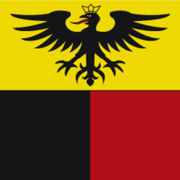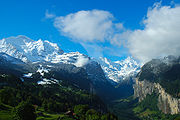
Bernese Oberland
Encyclopedia

Switzerland
Switzerland name of one of the Swiss cantons. ; ; ; or ), in its full name the Swiss Confederation , is a federal republic consisting of 26 cantons, with Bern as the seat of the federal authorities. The country is situated in Western Europe,Or Central Europe depending on the definition....
, in the southern end of the canton: The area around Lake Thun
Lake Thun
Lake Thun is an Alpine lake in the Bernese Oberland in Switzerland. It took its name from the city of Thun, on its northern shore.Lake Thun's approximately 2,500 km² large catchment area frequently causes local flooding after heavy rainfalls...
and Lake Brienz
Lake Brienz
Lake Brienz is a lake just north of the Alps, in the Canton of Berne in Switzerland. The lake took its name from the village Brienz on its northern shore. Interlaken and the villages Matten and Unterseen lie to the south west of the lake. The shores are steep, and there is almost no shallow water...
, and the valleys of the Bernese Alps
Bernese Alps
The Bernese Alps are a group of mountain ranges in the western part of the Alps, in Switzerland. Although the name suggests that they are located in the Bernese Oberland region of the canton of Bern, portions of the Bernese Alps are in the adjacent cantons of Valais, Lucerne, Obwalden, Fribourg and...
(thus, the inhabitable parts from approximately the level of Lake Thun at 558 m).
The flag of the Bernese Oberland consists of a black eagle in a gold field (in reference to the region's old status as reichsfrei) over two fields in the cantonal colours of red and black.
The Swiss German
Swiss German
Swiss German is any of the Alemannic dialects spoken in Switzerland and in some Alpine communities in Northern Italy. Occasionally, the Alemannic dialects spoken in other countries are grouped together with Swiss German as well, especially the dialects of Liechtenstein and Austrian Vorarlberg...
dialects spoken in the Bernese Oberland are Highest Alemannic German
Highest Alemannic German
Highest Alemannic is a branch of Alemannic German and is often considered to be part of the German language, even though mutual intelligibility with Standard German and other non-Alemannic German dialects is very limited....
, contrasting with the High Alemannic Bernese German
Bernese German
Bernese German is the dialect of High Alemannic German spoken in the Swiss plateau part of the canton of Bern and in some neighbouring regions.- Varieties :There is a lot of regional variation within Bernese German dialects...
spoken in Bern and the northern parts of the canton.
The Oberland is one of five regions or administrative subdivisions of the canton.
In the short-lived Helvetic Republic
Helvetic Republic
In Swiss history, the Helvetic Republic represented an early attempt to impose a central authority over Switzerland, which until then consisted mainly of self-governing cantons united by a loose military alliance, and conquered territories such as Vaud...
(1798-1803), the Bernese Oberland had been a separate canton, (Canton of Oberland
Canton of Oberland
Oberland was the name of a canton of the Helvetic Republic , corresponding to the area of the Bernese Oberland, with its capital at Thun....
).
Administrative division
Since 2010, the Oberland has been one of five regions of the canton of Bern, divided into four subregions- ThunThun (administrative district)Thun District in the Canton of Bern was created on 1 January 2010. It is part of the Oberland administrative region. It contains 35 municipalities with an area of and a population of 103,233....
- Obersimmental-SaanenObersimmental-Saanen (administrative district)Obersimmental-Saanen District in the Canton of Bern was created on 1 January 2010. It is part of the Oberland administrative region. It contains 7 municipalities with an area of and a population of 16,784....
- Frutigen-NiedersimmentalFrutigen-Niedersimmental (administrative district)Frutigen-Niedersimmental District in the Canton of Bern was created on 1 January 2010. It is part of the Oberland administrative region. It contains 13 municipalities with an area of and a population of 38,871....
- Interlaken-OberhasliInterlaken-Oberhasli (administrative district)Interlaken-Oberhasli District in the Canton of Bern was created on 1 January 2010. It is part of the Oberland administrative region. It contains 29 municipalities with an area of and a population of 48,763....
Before 2010, the Oberland had consisted of the following districts
Districts of Switzerland
In contrast to centrally organised states, in the federally constituted Switzerland each canton iscompletely free to decide its own internal organisation. Therefore there exists a variety of structures and terminology for the subnational entities between canton and municipality, loosely termed...
:
- Thun (district)Thun (district)Thun District was one of the 25 administrative districts in the canton of Bern, Switzerland. Its capital was the municipality of Thun. The district had an area of 285 km² and consists of 27 municipalities:-References:...
- Interlaken (district)Interlaken (district)Interlaken District in the canton of Bern with administrative capital Interlaken comprised 23 municipalities over 724 km²:*CH-3803 Beatenberg*CH-3806 Bönigen*CH-3855 Brienz*CH-3856 Brienzwiler*CH-3707 Därligen*CH-3818 Grindelwald...
- Oberhasli (district)
- Frutigen (district)Frutigen (district)Frutigen District was a district in the canton of Bern in Switzerland with its seat at Frutigen. It included seven municipalities in an area of 490 km²:-References:This article is based on a translation of an article from the German Wikipedia....
- Obersimmental (district)Obersimmental (district)Obersimmental District was one of the 26 administrative districts in the Canton of Bern, Switzerland. Its capital was Blankenburg in the municipality of Zweisimmen. The district had an area of 334 km² and consisted of 4 municipalities:-References:...
- Niedersimmental (district)Niedersimmental (district)Niedersimmental District was one of the 26 administrative districts in the canton of Bern, Switzerland. Its capital was the municipality of Wimmis. The district had an area of 319 km² and consisted of 9 municipalities:-References:...
- Saanen (district)Saanen (district)Saanen District was one of the 26 administrative districts in the canton of Bern, Switzerland. Its capital was the municipality of Saanen. The district had an area of 241 km² and consisted of 3 municipalities:-References:...
Tourism




- Gstaad-SaanenlandGstaadGstaad is a village in the German-speaking section of the Canton of Berne in southwestern Switzerland. Part of the municipality of Saanen, Gstaad is known as one of the most exclusive ski resorts in the world....
- LenkLenk im SimmentalLenk im Simmental is a municipality in the Obersimmental-Saanen administrative district in the canton of Bern in Switzerland.-History:Lenk is first mentioned in 1370 as An der Leng....
/SimmentalSimmentalSimmental is an alpine valley in the Bernese Oberland of Switzerland. It expands from Lenk to Boltigen, in a more or less South-North direction , and from there to the valley exit at Wimmis near Spiez it takes a West-East orientation . It comprises the municipalities of Lenk, St... - AdelbodenAdelbodenAdelboden is a municipality in the Frutigen-Niedersimmental administrative district in the Bernese Oberland in Switzerland.-Geography:Adelboden lies in the west of the Berner Oberland, at the end of the valley of the Engstlige river, which flows in Frutigen into the Kander river.Adelboden is a...
-FrutigenFrutigenFrutigen is a municipality in the Bernese Oberland in the canton of Bern in Switzerland. It is the capital of the Frutigen-Niedersimmental administrative district.-History:... - Lake ThunLake ThunLake Thun is an Alpine lake in the Bernese Oberland in Switzerland. It took its name from the city of Thun, on its northern shore.Lake Thun's approximately 2,500 km² large catchment area frequently causes local flooding after heavy rainfalls...
- Lötschberg area
- InterlakenInterlakenInterlaken is a municipality in the Interlaken-Oberhasli administrative district in the Canton of Bern in Switzerland, a well-known tourist destination in the Bernese Oberland.-History:...
- WengenWengenWengen may refer to:*Wengen, a village and winter resort in Switzerland*La Val, a commune in South Tyrol, Italy with the German name "Wengen"*in Germany:**Wengen , a village in the municipality of Nennslingen in Mittelfranken...
/MürrenMürrenMürren is a traditional Walser mountain village in Bernese Oberland, Switzerland, at an elevation of 1,650 m above sea level and unreachable by public road....
/Lauterbrunnental - GrindelwaldGrindelwaldGrindelwald is a municipality in the Interlaken-Oberhasli administrative district in the canton of Bern in Switzerland. The village is located at above sea level in the Bernese Alps.-Winter sports:...
- HaslitalHaslitalThe Hasli region is a historical Landvogtei or Talschaft in the Bernese Oberland, Switzerland, bordering on the cantons of Obwalden, Uri and Wallis...

